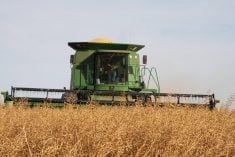The federal government is giving the canola industry more money to help find a home for products coming out of its rapidly expanding crushing sector.
Saskatchewan MP Randy Hoback announced $1.16 million in funding for oil and meal promotion at the Canola Council of Canada’s annual meeting in Saskatoon.
“Our government is proud to help spread the word about this amazing product,” said Hoback.
He said the government is happy to invest in an industry that sold 12 million tonnes of seed, oil and meal in 2010 worth more than $6 billion.
Read Also

Farm groups ask feds for export sales reporting
The Agricultural Producers Association of Saskatchewan and SaskCrops asks the federal government to create an Export Sales Reporting program.
“I’d hate to imagine what our communities would look like if there wasn’t canola because I know in the ’80s and ’90s, canola was what paid the bills,” Hoback told conference delegates.
“This investment will help the council develop new markets and strengthen existing ones.”
Council president JoAnne Buth said it is a wise investment.
“About 85 percent of canola grown in Canada is exported, so our marketing efforts are incredibly important to the health of our entire industry,” she said.
Cory McArthur, vice-president of market development with the council, said the government’s contribution will be matched by grower check-off money to provide extra clout to the council’s oil and meal promotion efforts.
The money will be spent on the council’s marketing efforts in the United States, Mexico, China and India.
In the U.S., the money will go toward established joint marketing efforts with groups such as the American Heart Association and the American Diabetes Association.
In India and China, the council will launch brand new marketing campaigns.
McArthur said there is a great opportunity to expand sales in India, which consumes little canola oil but is the diabetes capital of the world. An estimated 35 million Indians have type 2 diabetes.
Canola council plans for life in an open market
Wheat and barley aren’t the only commodities contemplating life after the demise of the Canadian Wheat Board’s single desk.
“We’ve just started the discussions internally because clearly it has an impact on acres,” said JoAnne Buth, president of the Canola Council of Canada.
There are still more questions than answers: Will wheat and barley acres go up or down? Where are prices heading? What will happen to market development?
“I don’t really see that there’s going to be a dramatic change in terms of wheat acres versus canola acres,” said Buth.
The council wonders if more players participating in wheat marketing will mean higher prices for the commodity. If that’s the case, it could result in more acres devoted to wheat on the Prairies.
Buth said it wouldn’t necessarily be a bad thing for the canola industry. Canola growers have been pushing their acres and there will be consequences if that practice continues.
“We’re going to start to see yields come down,” said Buth.
“It might be a good thing for us if there’s a stronger wheat price because then we might see more balancing out in terms of the acres.”
She said there is also speculation that transportation will be more efficient in a post-CWB monopoly world, which would benefit the canola industry.















